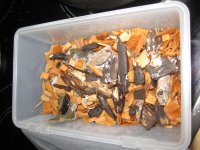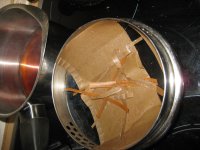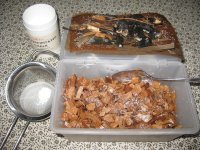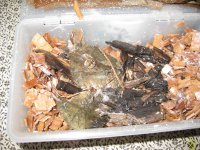downwardsfromzero
Boundary condition
So, here's a couple of pics: some lightly simmered wood chips freshly 'inoculated' with what reasonably may be assumed to be either Ps. cyanescens or Ps. ovoideocystidiata mycelium, and some cardboard that was simmered in the resulting wood tea. The cardboard will be covering the wood chips to help regulate moisture levels.
After finding the long-lost mycelium in a few wood chips these were kept in a small, empty peanut packet along with a dead leaf. The manner in which the mycelium colonised the leaf, along with the resulting fragrance signature indicates that this most likely will be cyanescens.
The wood chips were sold as hardwood reptile bedding. A suitable quantity for the plastic tub being used, in this case 200mL, was placed into a stainless steel saucepan and about 400mL of boiling water was poured on. The pan was placed on a low heat and simmered for about 10 mins.
The water was then strained off while hot into the plastic tub. This sterilises the tub a little. The wood chips were put in a sieve to drain and sprinkled lightly with table salt. This is because Ps. cyanescens is fairly salt tolerant and it will thus be favoured slightly over competing moulds.
To the remaining 250mL of wood tea was added 30mL of 25% acetic acid solution, to make a weak wood vinegar of sorts. Excess salt was rinsed from the wood chips using this solution. This was then used to simmer a piece of unbleached corrugated cardboard which had been cut to a suitable size to cover snugly the surface of the wood chips in the plastic tub.
[EDIT: See note below about neutralisation using calcium carbonate!]
Once the wood chips had cooled sufficiently, the mycelium was added in a thin layer. Excess liquid was removed from the soaked cardboard using a paper towel. The cardboard was allowed to cool and place atop the mycelium in the tub, which was closed with a fairly loose-fitting lid.
The tub was put in a cool (10-15°C), dark place to incubate.
We await further signs of life...
After finding the long-lost mycelium in a few wood chips these were kept in a small, empty peanut packet along with a dead leaf. The manner in which the mycelium colonised the leaf, along with the resulting fragrance signature indicates that this most likely will be cyanescens.
The wood chips were sold as hardwood reptile bedding. A suitable quantity for the plastic tub being used, in this case 200mL, was placed into a stainless steel saucepan and about 400mL of boiling water was poured on. The pan was placed on a low heat and simmered for about 10 mins.
The water was then strained off while hot into the plastic tub. This sterilises the tub a little. The wood chips were put in a sieve to drain and sprinkled lightly with table salt. This is because Ps. cyanescens is fairly salt tolerant and it will thus be favoured slightly over competing moulds.
To the remaining 250mL of wood tea was added 30mL of 25% acetic acid solution, to make a weak wood vinegar of sorts. Excess salt was rinsed from the wood chips using this solution. This was then used to simmer a piece of unbleached corrugated cardboard which had been cut to a suitable size to cover snugly the surface of the wood chips in the plastic tub.
[EDIT: See note below about neutralisation using calcium carbonate!]
Once the wood chips had cooled sufficiently, the mycelium was added in a thin layer. Excess liquid was removed from the soaked cardboard using a paper towel. The cardboard was allowed to cool and place atop the mycelium in the tub, which was closed with a fairly loose-fitting lid.
The tub was put in a cool (10-15°C), dark place to incubate.
We await further signs of life...




